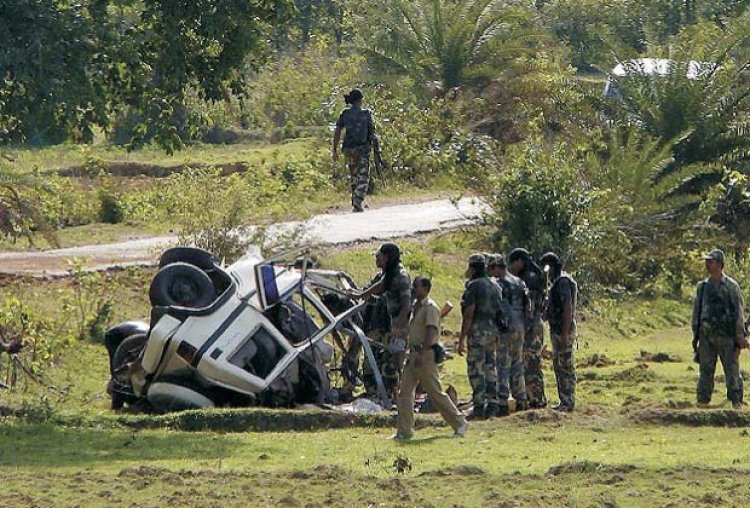Though Still a Grave Threat, Maoists are a Fighting a Losing Battle
Amulya Ganguli

As the death of 22 security personnel in a gun battle with the Maoists in Chhattisgarh shows, Left extremism continues to remain a major threat, as former prime minister Manmohan Singh once said. Although there have been ups and downs in the nature of the danger – Maoist violence had been restricted to 60 districts of eight states in 2018 against its prevalence in 76 districts of 10 states in 2013 – the latest incident showed that the militants have managed to survive in their jungle hideouts with enough capacity to be a menacing, if shadowy, presence.
The fact that they used light machine guns and AK-47s not only indicated their preparedness to fight for a long time – the encounter lasted for five hours – but also that they had a substantial armoury. Moreover, their tactical one-upmanship was evident from the trick of having earlier evacuated some of the nearby villages so that when the security forces took their injured personel to the huts, they were fired on by the Maoists stationed there.
The firefight followed the entry of the paramilitary Central Reserve Police Force (CRPF) into the area in search of the Maoist commander, Madvi Hidma, who is believed to be the mastermind of several offensives including the wiping out of nearly the entire top Congress leadership of the region in 2013 and also the attack against a CRPF convoy in 2010 in which 76 policemen were killed and an ambush in 2017 in which 24 CRPF personnel were killed.
A local who has variously been described as a tribal or a Dalit, suggesting a confusion about his background, HIdma is an archetypal Maoist insurgent who has risen through the ranks of the rebels from humble beginnings to be a leader who carries a reward of Rs 40 lakh on his head. Although the average Maoist leader is generally a middle class Hindu like Hidma’s predecessor, the late Ravula Srinivas, who carried a reward of more than Rs one crore on his head, the Maoists have always envisaged the impoverished subalterns as the foot soldiers of their insurrection on the lines of Mao Zedong’s peasant revolution based in villages. (The classical Marxism of Lenin is town- and industry-centric).
Before Hidma, there was Jangal Santhal in West Bengal’s Naxalbari, the area from where the Maoists, also known as Naxals, derive their name. Santhal was a tribal and one of the three major leaders of the movement when it began in the mid-1960s. The other two were Charu Mazumdar and Kanu Sanyal, who were middle class Bengalis. It was from that small town in the foothills of the Himalayas that Naxalism/Maoism spread like a “prairie fire”, as Radio Beijing called it.
Given the number of splits which the Maoists have suffered, especially after they became an urban phenomenon in West Bengal in the 1970s, their ability not only to survive for more than half a century, but also be regarded as a dangerous force underlines both their organizational capability and ideological fervour. It is not known how effectively the Maoists have been able to indoctrinate their cadres and simple-minded villagers with their version of Mao Zedong Thought.
But their presence in several states, of which Chhattisgarh is currently the most prominent, emphasizes their ability to promulgate their message either through the teaching of Maoist tenets against capitalism and parliamentary democracy or simply by terrorizing the villagers into silent acquiescence in their doctrine.
It is also possible that they have undertaken basic social services to secure local support by providing rudimentary medical care and ensuring a modicum of peace. In this respect, the Maoists are not unlike some of the dacoit gangs of the past, mainly in neighbouring Madhya Pradesh, who, too, lived among the villagers and took care of their needs with a kind word and a gun, as Al Capone said about his methods to keep his “followers” in line. Some of these dacoits also became well known as Phoolan Devi did, and have had films like the “Bandit Queen” made about their lives and times.
In view of the reputation of the Maoists for ruthlessness, it is obviously extremely difficult for any of the villagers to act as police informers. It is obviously because of this fearful image that the police have not been able to make much headway into ascertaining the whereabouts of the Maoist leaders despite the use of drones for aerial surveillance. Nor can the security forces replicate the brutality of the Maoists even during the encounters lest the villagers suffer as a consequence. From this standpoint, the police are generally one step behind in the matter of taking their adversaries headon.
However, notwithstanding the presence of the Maoists in several states and their occasional gun battles with the security forces, few will deny that they are fighting a losing battle. Like the dacoit gangs, they will forever remain outlaws, cooped up their jungle redoubts and unable to indulge in anything more than create mayhem now and again. There is little chance of their Mao Zedong Thought becoming the dogma of the land.
Like the other communist parties – the CPI, the CPI(M) and the CPI(M-L) – the Maoists, who are the offshoots of these parties, are seemingly destined to remain in the margins of national life. The only difference is that while the other three have accepted parliamentary democracy as their creed, the Maoists continue to repose their faith in establishing the dictatorship of the proletariat after overthrowing the bourgeoise state. It will be an unfulfilled dream despite their occasional violent outbursts.
















